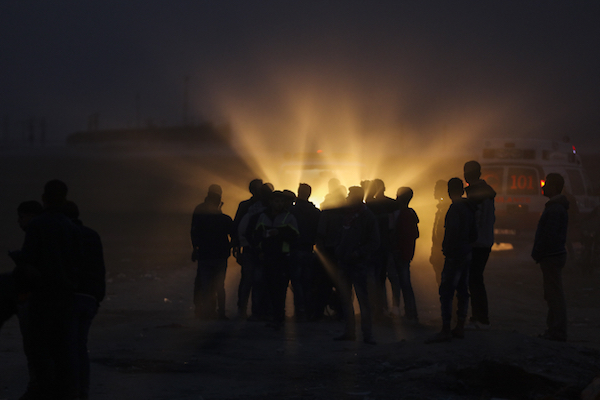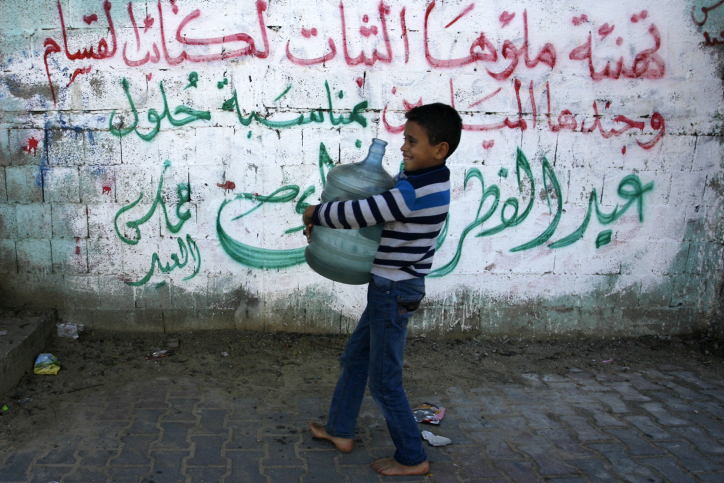The deliberate suffocation of Gaza began in the 90s, when the first restrictions on the movement of Palestinians were introduced.
By Amir Rotem

A macabre drama has been playing out every Friday along the border fence separating the Gaza Strip and Israel, complete with live broadcasts, press coverage, commentary, and even real-time spectators. An armed military stands on one side of the fence, a mass of angry residents on the other. The world, and let’s admit it, most Israelis, generally prefer not to see Gaza. When they do, it is almost always in the context of a violent escalation.
The current wave of protests — a Palestinian initiative bookended by Land Day on one side and Nakba Day on the other — is compelling the world, Israelis included, to see Gaza and pay attention to its residents. The horrifying death toll and the hundreds wounded whose lives are forever altered, all on the Palestinian side, push us toward a more nuanced reading of reality than those offered by Israeli propaganda. Israel has maintained an intimate and intense relationship with Gaza’s residents for decades, day in day out — even when there is no shooting, even when no one is watching.
After years of slowly gliding down a slippery slope, the situation in Gaza has been in free fall over the course of the last year. A United Nations report once estimated that by 2020, Gaza would become unlivable. The estimate has since been modified to 2018.
The facts are well-known: a faltering electricity supply which, even when the system runs at its capacity (and it never does truly run at capacity) only meets half of actual demand; household taps only offering unportable water; partial and deficient waste disposal; a severe shortage of housing, schools and medical facilities; dangerous shortages in medicine and essential medical equipment; and some of the highest unemployment rates in the world, if not the highest, especially among young people, who make up the majority of Gaza’s population.
The road to the present moment has been drawn-out and torturous. Things did not start with the recent Land Day protests, nor with the tightening of Israel’s closure on Gaza following the Hamas takeover in 2007. The deliberate suffocation of life in the Strip began long ago, when the first restrictions on the movement of Palestinians were introduced in the early 1990s. Contrary to popular belief, the motivation for these restrictions was never based solely on security concerns, nor was it ever explained as such.
Gaza residents have been taken hostage in a fierce contest of narratives. The rift between the Palestinian factions has greatly exacerbated the deterioration of living conditions in the Strip over the last year, as has Egypt’s effective closure of the Rafah Crossing, which is coordinated with Israel. A cautious, preoccupied international community has failed to keep its promises to fund the reconstruction of the region, following mass destruction wrought by the hostilities in the summer of 2014.
The most consistent, unwavering authority — which has vanquished almost all hope from the lives of Gaza residents — is Israel. For 50 years, Israel has held the power to approve or deny the development of suitable infrastructure and advancement of economic activity. Israel forcefully determines where people may live, whether they can exercise their right to freedom of movement, and therefore, the extent of their access to livelihoods, education, family life, and self-fulfillment.

Israel’s entire political paradigm concerning Gaza boils down to its labeling its residents as fundamentally dangerous. It administers a stringent permit regime governing their movement, and subjects them to myriad unlawful collective punishments. Faced with the blatant failure of the closure’s original objectives, and in the absence of policy, all that remains is rhetoric. Israel’s leadership, from the prime minister and his cabinet to top military officers and their advisers, has been talking about Israel’s commitment to Gaza’s reconstruction ever since 2014. They describe it as in Israel’s interest, while citing the importance of delaying the next round of hostilities, saving the environment, promoting regional stability, and mitigating its obsession with Iran. Never, however, because it is the right thing to do, the only moral option, and the only legal one. Yet regardless of rhetoric, the situation on the ground stays the same.
Gaza’s residents live in manufactured, premeditated, unnecessary distress. The people demanding a life worth living in the Gaza Strip are not a terrorist organization. They are human beings, as deserving of basic human rights as the readers of this piece. When hatred and severe restrictions fail, the time comes to consider alternatives. When there are no military quick-fixes to the situation, it’s time to move toward political solutions. Gaza residents of all ages are coming to the fence and saying – look at us, we’re here, and we’re just like you. The time has come to meet their gaze.
Amir Rotem is the director of the public department at Gisha, an Israeli human rights NGO working to promote freedom of movement of Palestinians, especially Gaza residents. This article was first published in Hebrew on Local Call. Read it here.
